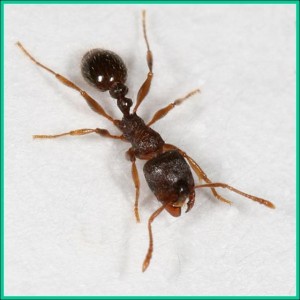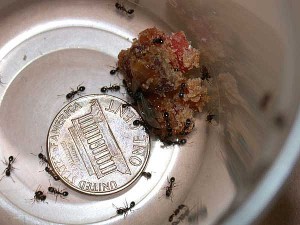
Pavement Ants
Pavement ants (Tetremorium immigrans)
Pavement ants are the small, reddish brown ants commonly seen along pavement and sidewalks. They are known to feed on both greasy and sweet foods. Very often they build their nests along sides of garages and houses, and parts of houses which are constructed on concrete slabs. They enter dwellings through cracks in basement walls or concrete floors, or through basement windows and doors. It is possible for them to build their nest under a poured concrete slab if adequate access (cracks) is found. Pavement ants are more likely to be found indoors during the winter months because the ants seem to prefer to forage outdoors for their natural foods during the summer.
Winged forms or reproductives issue from mature colonies appear in late spring and summer. Like other winged ants, the reproductives are quite a bit bigger than the workers and commonly find their way indoors. Winged pavement ants pose no threat and generally disappear in a week or two.
During the winter worker pavement ants are not usually active because of the cold temperatures, however, nests built along or under heated structures may remain active during the winter which more or less forces the ants to come indoors and forage for food and water. Swarmers or winged reproductives may appear during the spring and summer, but the swarming period is usually very short and the occurrence of these ants is normally short-lived. Swarmers may also appear in heated structures during the winter months when colonies are located very close to the building’s foundation.
The best methods of control include: 1) Caulking any crack in the walls or floors where the ants are observed entering the dwelling; 2) Feeding them a poisoned bait; or 3) Spraying the foundation and a 5 foot border around the house with a persistent insecticide such as permethrin (sold under a variety of brand names, cyfluthrin (sold as Bayer Advanced Garden Insect Control for homeowners or Tempo for commercial applicators) or one of the Ortho products. Keep pets and children away until the spray dries. These sprays will probably not destroy the nest since pavement ant nests may be located quite deep in the soil and these materials do not penetrate very far down into the soil.
Baits can be prepared by adding 1/2 tsp. of boric acid powder to 1/4 cup of ground dry dog or cat food + 1 tsp. molasses. Place a teaspoon of this mixture on jar lids and set them where the ants are seen indoors. Be sure pets and small children cannot get into the bait. Poisoned baits may not be effective if the ants are not actively seeking food or if there are other, more preferred foods or liquids are available. Because of the availability of their favorite foods during the warm months of the year, baits tend to be more effective during the winter months.
Be sure to read and follow all instructions and safety precautions found on the label before using any pesticide.





 Print
Print Email
Email




